The best lakes for Milky Way photography combine dark skies with calm water for mirror-like reflections. Top North American spots include Two Jack Lake, Vermilion Lakes, Moraine Lake, Blue Lake, and Lake Minnewanka. Internationally, Lake Tekapo in New Zealand offers exceptional Southern Hemisphere views within a dedicated dark sky reserve. You’ll want to plan your shoot during new moon phases between late spring and early fall for ideal visibility. The right planning tools and equipment can transform your night sky captures.
Essential Factors for Lake Milky Way Photography

When capturing the Milky Way over lakes, several essential factors will determine the success of your astrophotography. First, prioritize locations with dark skies and minimal light pollution like Two Jack Lake and Vermilion Lakes near Banff. The darker your environment, the more vibrant the galaxy will appear in your images.
Timing is vital—schedule your shoot between late spring and early fall when the Milky Way’s core is most visible. Plan around the new moon phase to maximize darkness and stellar visibility.
For the most dramatic compositions, seek out lakes with calm surfaces that create mirror-like reflections of the galaxy.
Finally, don’t overlook logistics—research access routes to your chosen location and prepare for wildlife encounters by taking appropriate safety precautions.
Dark Sky Lakes in North America Worth Visiting
While many photographers journey far for pristine night skies, North America boasts several exceptional lakes that combine dark sky conditions with stunning reflective surfaces.
Banff National Park stands out with multiple premier locations, including Two Jack Lake where you’ll capture perfect Milky Way alignment above Mount Rundle. Nearby Lake Minnewanka offers dark skies surprisingly close to urban areas, making it accessible for night shoots.
- Two Jack Lake provides mirror-like reflections of the Milky Way core
- Vermilion Lakes offers versatile shooting conditions for day and night photography
- Moraine Lake’s High Sierra landscape creates dramatic celestial backdrops
- Blue Lake in Colorado’s San Juan Mountains excels during meteor showers
- Lake Minnewanka combines accessibility with exceptional dark sky conditions
International Lake Destinations for Astrophotographers
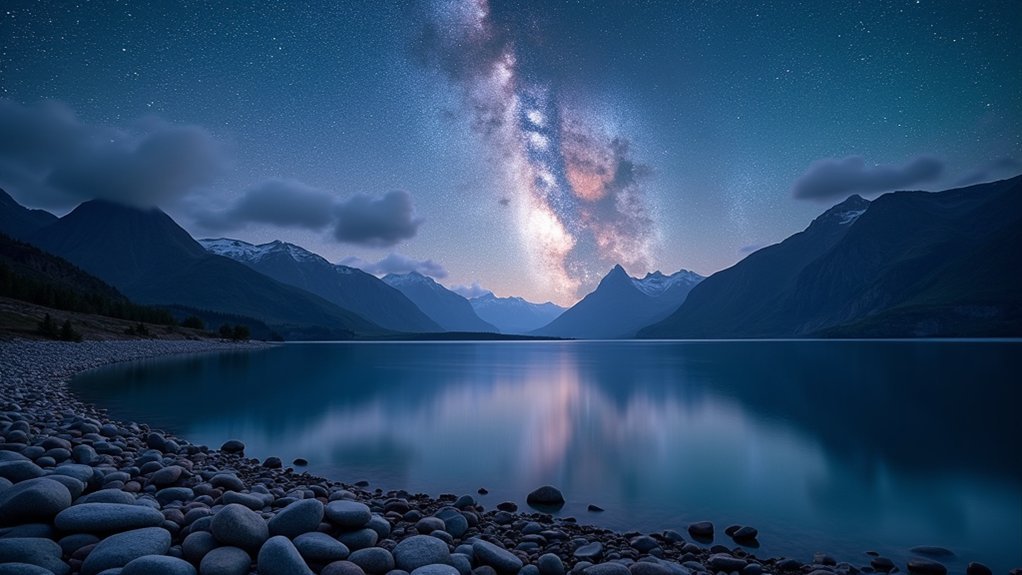
Beyond North America’s exceptional waters, the international stage offers astrophotographers extraordinary lake destinations that showcase different celestial perspectives.
Lake Tekapo in New Zealand stands out as a premier destination within a dedicated dark sky reserve. Here, you’ll capture the Southern Hemisphere’s unique stars and the prominent Milky Way core reflected in crystal clear waters. The lake’s isolation from major light pollution sources creates ideal conditions for night sky photography.
New Zealand’s Lake Tekapo offers unrivaled Southern Hemisphere stargazing in pristine dark skies above mirror-like waters.
While North America boasts impressive options like Minnewanka, Jasper, and Moraine in Canada, these international waters provide alternative seasonal viewing opportunities and distinct celestial features.
Lake Tekapo’s southern location offers astrophotographers access to astronomical features not visible from northern latitudes, making it worth the journey for those seeking to expand their portfolio with diverse night sky perspectives.
Seasonal Considerations for Capturing Lake Reflections
While spring offers brief stargazing windows between rain showers when lakes begin to calm after winter storms, summer delivers unmatched clarity with minimal humidity and longer nights for perfect Milky Way reflections.
You’ll find the warmth of summer nights allows for comfortable extended shooting sessions without condensation issues on your gear.
Winter transforms many northern lakes into beautiful ice mirrors, creating unique crystalline foregrounds for Milky Way compositions, though you’ll need to prepare for extreme cold and shorter shooting periods.
Spring Stargazing Windows
As winter releases its grip, spring emerges as a prime season for Milky Way photography at lakes.
You’ll benefit from longer nights and clearer skies that create perfect conditions for capturing the Milky Way core’s reflection on lake surfaces. The seasonal combination of melting snow and rainfall enhances water levels, providing more expansive reflective surfaces for your nighttime shots.
- Time your photography sessions around spring new moons to minimize light pollution
- Visit high-elevation lakes like Two Jack Lake where spring brings fewer crowds
- Look for the Milky Way core becoming visible in late spring
- Take advantage of the alignment between lakes and the galactic center
- Prepare for cooler spring temperatures that often result in clearer atmospheric conditions
Summer Clarity Benefits
Summer months offer exceptional conditions for Milky Way photography with lakes providing perfect reflecting surfaces.
You’ll benefit from clearer skies and lower humidity, dramatically enhancing visibility of the galactic core. Popular destinations like Two Jack Lake and Vermilion Lakes in Canada showcase stunning night photography potential with their calm, warm evening waters creating mirror-like reflections.
August brings an added bonus—the Perseid Meteor Shower—introducing dynamic streaks across your compositions.
The extended daylight hours of summer actually work in your favor, giving you more time to scout locations before darkness falls. Without winter’s snow and ice barriers, you’ll enjoy easier shoreline access, allowing ideal tripod placement for those perfect reflection shots.
These combined factors make summer the prime season for capturing the Milky Way’s splendor reflecting off still lake waters.
Winter Lake Freeze
When temperatures plummet below freezing, lakes transform into natural mirrors that elevate Milky Way photography to extraordinary levels.
You’ll find that clear, cold nights provide superior visibility of the stars against the smooth, reflective surface of frozen lakes.
- Check ice thickness for safety before venturing onto frozen lakes
- Visit locations like Vermilion Lakes and Two Jack Lake for unique winter compositions
- Look for undisturbed ice surfaces that maximize reflection quality
- Take advantage of surrounding snow as a natural brightness enhancer for your foreground
- Schedule shoots during the coldest nights when air clarity is at its peak
The contrast between the dark sky and bright frozen landscape creates dramatic compositions not possible in other seasons.
Winter’s frozen lakes offer photographers distinct advantages when capturing the galaxy’s splendor against Earth’s transformed aquatic landscapes.
Planning Your Shoot With Apps and Tools
Modern Milky Way photographers rely on specialized apps like PhotoPills and Stellarium to predict perfect galactic alignments over lakes with pinpoint accuracy.
Light pollution maps from DarkSiteFinder will guide you to pristine dark sky locations where stars pop against tranquil waters without urban glow interference.
Weather prediction tools including Clear Sky Chart enable you to anticipate cloud cover, humidity, and atmospheric conditions that directly impact your lake reflection quality.
Mobile Apps for Planning
How can you maximize your chances of capturing that perfect Milky Way shot over a tranquil lake? The right mobile apps can transform your night photography planning process, eliminating guesswork and ensuring ideal conditions.
- PhotoPills and Star Walk apps reveal the Milky Way’s precise position, helping you align it perfectly with your chosen lake foreground.
- Clear Outside provides detailed cloud cover predictions essential for selecting clear nights for your shoot.
- DarkSky’s light pollution maps guide you to the darkest lakes, away from city light interference.
- Sun Surveyor tracks sunset timing so you’ll know exactly when ideal night conditions begin.
- Star tracker apps alert you to celestial events like meteor showers that can enhance your lakeside Milky Way compositions.
With these digital tools, you’ll arrive at the perfect location at precisely the right moment for breathtaking results.
Light Pollution Maps
Light pollution maps serve as your secret weapon for finding pristine lake locations with truly dark skies. Websites like DarkSky.org visually classify areas based on light pollution levels, with black and dark blue zones representing the ideal spots for Milky Way photography.
| Map Resource | Features | Best For |
|---|---|---|
| DarkSky.org | Visual gradient maps | Initial scouting |
| Dark Sky Finder | Color-coded zones | Detailed planning |
| PhotoPills | Integration with planning tools | On-location assessment |
| Community Forums | User-verified locations | Real-world validation |
Combine these maps with local terrain information to identify lakes at least 45 minutes from urban areas. You’ll maximize your chances of capturing clear galactic views by cross-referencing multiple light pollution resources. Many photographers share their successful shooting locations online, providing valuable supplementary information beyond what maps alone can tell you.
Weather Prediction Tools
Because weather conditions can make or break your Milky Way photography session, reliable prediction tools have become essential gear for night sky photographers.
The clear, Dark Sky visibility you’ll need requires careful planning with specialized apps and resources.
- Clear Outside and Weather Underground provide detailed cloud cover forecasts, helping you identify perfectly clear nights.
- Photopills calculates the Milky Way’s position, allowing you to align it with your chosen lake landscape.
- Timeanddate.com offers lunar phase information to avoid shooting when bright moonlight washes out the galactic core.
- Local weather services help track wind speeds and temperature, as calm conditions with low humidity deliver sharper stars.
- Combine these predictions with Dark Sky Finder maps to guarantee your chosen lake location will have minimal light interference.
Equipment Essentials for Lake Astrophotography on a Budget
Five essential pieces of gear will get you started with lake astrophotography without breaking the bank.
First, consider an older camera like the Canon 6D that offers manual settings vital for long exposure shots of the night sky. Pair it with a 14mm wide-angle lens to capture expansive views of the Milky Way arching over lake reflections.
A sturdy tripod is non-negotiable when shooting exposures ranging from 20 to 300+ seconds. To eliminate camera shake, use a remote shutter release or your camera’s self-timer function.
Finally, invest in post-processing software such as Adobe Lightroom or Photoshop. These tools will help you enhance your Milky Way details and adjust exposure levels, transforming good captures into breathtaking final images.
Weather Patterns and Their Effect on Lake Photography

When planning your perfect Milky Way shot over water, weather conditions will make or break your image. Clear skies with minimal humidity deliver the crispest star details and ideal sky viewing experiences.
Watch for regional forecasts and seasonal patterns, as late summer often combines clear visibility with special astronomical events like the Perseid shower.
- Check humidity levels—lower percentages reduce atmospheric distortion
- Monitor wind forecasts—calm conditions preserve mirror-like lake reflections
- Track temperature variations—warmer nights might create atmospheric mist
- Avoid cloud cover at all costs—even thin clouds diminish Milky Way visibility
- Consider seasonal patterns—summer storms can clear, leaving pristine conditions
Temperature differences between air and water can create dramatic fog effects that either enhance your composition or completely obscure your subject.
Timing your shoot around these weather patterns maximizes your chances of capturing breathtaking galactic reflections.
Composition Techniques for Lake Milky Way Shots
When composing your lake Milky Way shots, you’ll want to frame the night sky so its reflection creates a symmetrical mirror effect that doubles the visual impact.
Balance foreground elements like piers, rocks, or vegetation against the vastness of the cosmos to establish depth and a grounded focal point that leads the viewer’s eye.
Create a natural visual flow between the stars and lake by positioning yourself where the Milky Way’s arc appears to emerge from or return to the water, forming a continuous celestial circuit that keeps viewers engaged with your image.
Reflection Framing Strategies
Mastering reflection compositions can transform your ordinary Milky Way shots into breathtaking masterpieces that showcase both the celestial wonder above and its mirror image below.
Position yourself at the water’s edge, using lakes as natural mirrors to double the impact of your composition. Choose a wide-angle lens around 14mm to capture both the expansive sky and its reflection in a single frame.
- Select strategic foreground elements like rocks or trees to frame the Milky Way and add depth.
- Experiment with different positions around the lake to find the perfect balance between sky and reflection.
- Incorporate the shoreline as a leading line to draw viewers toward your celestial subject.
- Use the lake’s surface ripples to create interesting texture in your reflection.
- Try various angles to maximize the reflection’s impact while maintaining the Milky Way’s prominence.
Foreground Element Balance
Achieving perfect foreground balance transforms ordinary Milky Way lake shots into spectacular compositions that tell a complete visual story.
Position your camera at a low angle along the water’s edge to create harmony between the celestial display and terrestrial elements.
Incorporate rocks, driftwood, or shoreline vegetation that frame without overpowering the stars. These elements provide scale and context while creating leading lines that naturally guide viewers’ eyes toward the Milky Way.
When composing your shot, apply the rule of thirds by placing the horizon in either the upper or lower third of your frame. This strategic positioning emphasizes either the lakes’ reflective quality or the grandeur of the night sky above.
Remember that long exposures must capture detail in both the stars and their reflection, requiring careful attention to exposure settings that balance all elements.
Star-to-Lake Visual Flow
The perfect Milky Way photograph over water creates a seamless visual journey from heaven to earth. When shooting over lakes, position your composition to capture the galaxy’s reflection, creating symmetry that draws viewers through your image.
Experiment with 311-second exposures to balance stellar details with water elements while maintaining visual flow from foreground to sky.
- Align the Milky Way’s core directly above distinctive lake features
- Use rocks, piers, or tree silhouettes to create leading lines from water to stars
- Position the galactic reflection to mirror its celestial counterpart exactly
- Shoot during clear nights when stars and lakes achieve maximum visibility
- Create diagonal compositions that carry the eye from lake corner to opposite sky
Lakes like Two Jack offer ideal conditions where the Milky Way naturally aligns with landscape features, especially during meteor showers when the sky is most dramatic.
Finding Foreground Elements Around Lakes
While capturing the Milky Way alone can create breathtaking images, incorporating compelling foreground elements transforms ordinary night photography into visual stories with depth and context. Lakes offer an abundance of natural props that can elevate your composition dramatically.
Scout locations like Lake Cuyamaca during daylight hours to identify distinctive features—piers extending into the water, interesting rock formations, or silhouetted trees that frame the scene.
Daylight scouting reveals the natural frames and anchors that will give your night images storytelling power.
At Vermilion Lakes, you’ll find accessible shorelines with minimal walking from parking areas, allowing you to explore various compositional angles without struggling through difficult terrain at night.
The effort you put into finding these elements pays off when they’re reflected in calm waters, creating a mirror effect that doubles the visual impact of your image, as perfectly demonstrated at Two Jack Lake with Mount Rundle.
Addressing Light Pollution Near Popular Lakes

Despite the undeniable allure of popular lakes for night photography, light pollution remains the most significant challenge you’ll face when capturing the Milky Way.
Even renowned locations like Two Jack Lake and Vermilion Lakes near Banff can suffer from urban light interference, compromising your shots.
To overcome light pollution challenges:
- Travel at least 45 minutes away from city centers to find darker skies
- Use the Dark Sky Finder Map to identify lakes with minimal light pollution
- Consider high-elevation lakes in areas like the San Juan Mountains for clearer night visibility
- Seek coastal lakes with western-facing cliffs that naturally block artificial light
- Visit popular lakes during off-seasons when tourist activity (and associated lighting) is reduced
Remember that even a small amount of light pollution can dramatically affect the visibility of the Milky Way’s intricate details in your photographs.
Safety Considerations for Night Photography at Lakes
Venturing out to capture the Milky Way’s splendor over lakes demands careful attention to safety protocols that many photographers overlook in their excitement. Always inform someone about your location and expected return time before heading out to remote lakes.
| Safety Considerations | Why It Matters |
|---|---|
| Carry a flashlight | Prevents falls on uneven terrain and helps identify hazards |
| Travel in groups | Deters wildlife encounters like mountain lions |
| Check wildlife warnings | Avoids areas with recent cougar sightings |
| Learn lake topography | Minimizes risk around sudden drops or slippery rocks |
You’ll need to familiarize yourself with each lake’s specific hazards before setting up your equipment. By prioritizing these safety considerations, you can focus on capturing stunning Milky Way reflections without putting yourself at unnecessary risk.
Post-Processing Lake Milky Way Images

Once you’ve captured raw images of the Milky Way reflecting over still lake waters, the real magic begins in post-processing.
Transform your National Park night shots by enhancing the Milky Way core’s visibility through careful adjustments in contrast, brightness, and saturation using Lightroom or Photoshop.
- Reduce noise and sharpen details in long exposure shots to clearly define the intricate star patterns.
- Combine multiple images using stacking methods to dramatically enhance clarity.
- Apply color correction to maintain realistic representation of the night sky and lake reflections.
- Use masking techniques to selectively brighten the lake’s reflection without affecting the Milky Way.
- Balance the exposure between foreground elements and the night sky for a cohesive final image.
Frequently Asked Questions
Where Is the Best Place to Photograph the Milky Way?
The best places to photograph the Milky Way include Two Jack Lake and Vermilion Lakes in Banff National Park, East End of Rundle, the San Juan Mountains near Silverton, and Moraine Lake in the High Sierra.
Where in the USA Can You See Milky Way?
You’ll see stunning Milky Way views in Death Valley and Big Bend National Parks due to their extremely dark skies. The San Juan Mountains in Colorado also offer spectacular high-elevation viewing with minimal light pollution.
What Is the Rule for Milky Way Photography?
For Milky Way photography, you’ll need dark skies, a wide aperture (f/2.8 or wider), high ISO (1600-6400), long exposures (15-30 seconds), manual focus, and a sturdy tripod. Shoot during new moon phases for best results.
What Are the Best Conditions to See the Milky Way?
You’ll see the Milky Way best on moonless nights with clear skies, at high elevations far from city lights. Choose locations at least 45 minutes from urban areas during summer months for ideal core visibility.
In Summary
You’ve now discovered the world’s best lakes for Milky Way photography. Remember, the perfect shot requires dark skies, proper timing, and thoughtful composition. Whether you’re shooting at Crater Lake, Lake Tekapo, or your local waterfront, you’ll need patience and preparation. With the right equipment and techniques, you’re ready to capture stunning galactic reflections that showcase both heaven and earth in a single frame.
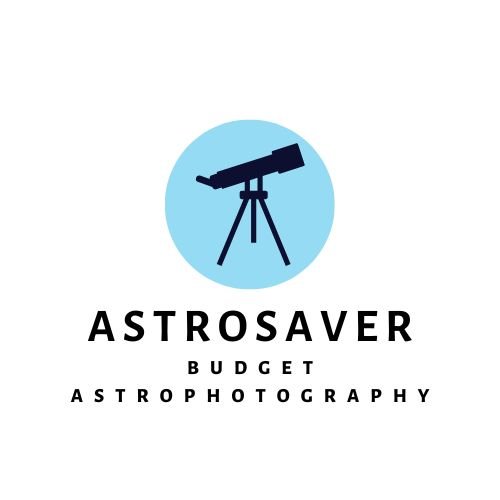
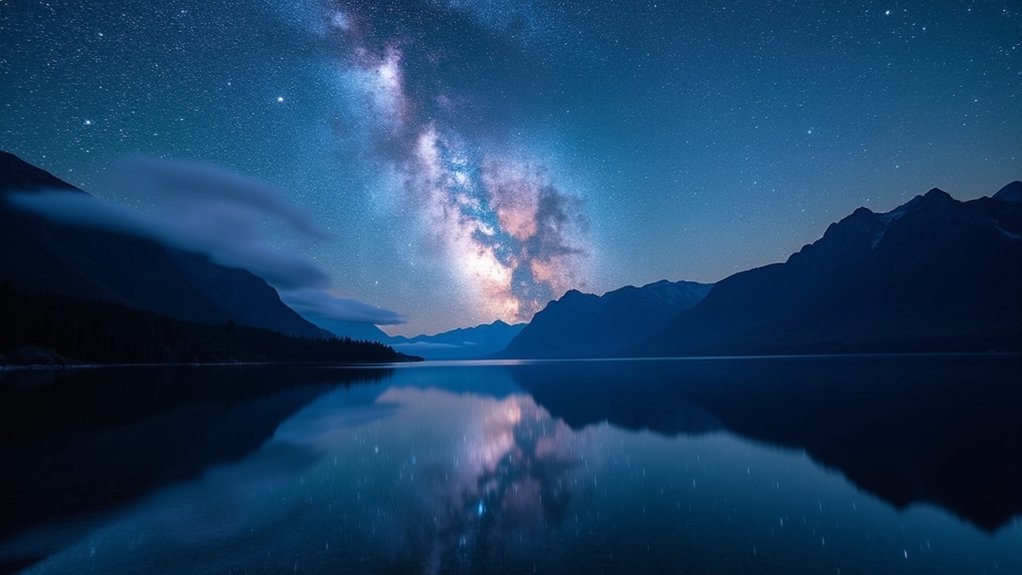
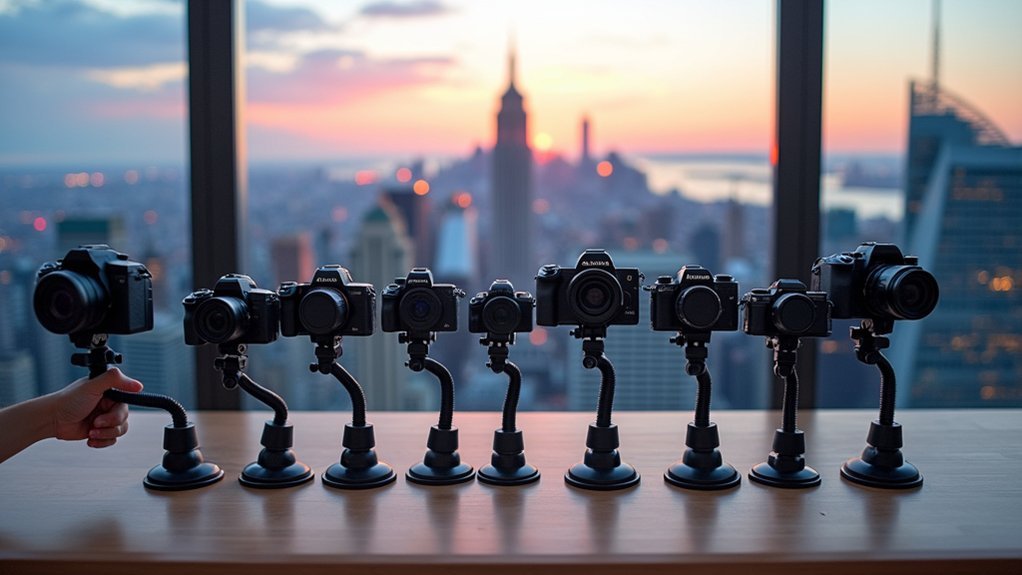

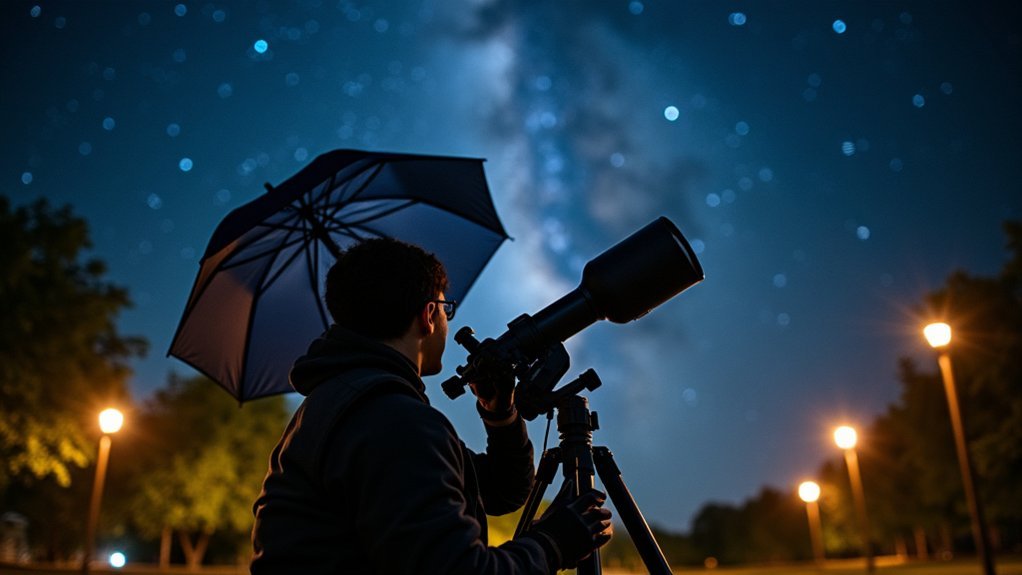
Leave a Reply